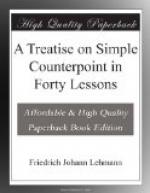The minor seventh, and the major and minor ninth of a chord, may be used freely on any but the first quarter, but must be consonant with the other part. [Fig. 57.]
[Illustration: Fig. 57.]
The first and third species may be mixed, as in Fig. 58.
[Illustration: Fig. 58.]
The second species may be used in one part and the third in the other, also six notes in one part and two in the other, and six in one and three in the other. All tones appearing simultaneously, must comply with the suggestions for tones appearing on the weak beat given in previous lessons, where both parts have other than the first species. [Fig. 59.]
[Illustration: Fig. 59.]
The cadences in Fig. 60 are good, and will suggest others.
[Illustration: Fig. 60.]
EXERCISES
To cantus firmus a write one counterpoint above and one below, in the third species.
To cantus firmus b write counterpoints in six notes, one above and one below. [Fig. 52.]
Write one eight-measure phrase, mixing the first and third species. [Fig. 58.]
Write two eight-measure phrases, using third species in both parts. [Fig. 55.]
CANTI FIRMI
[Illustration: Fig. 61.]
LESSON VI
FOURTH SPECIES
[Illustration: Fig. 62.]
This species is the same as the second, except that the last note of the measure is tied to the first note of the next, forming a syncopation. As in the second species, the first note of the counterpoint should form a unison, octave or fifth, and when the counterpoint begins on the second half it may also be an imperfect consonance.
When the counterpoint begins on the first half, the second half is treated the same as the second half of succeeding measures, described in the next paragraph.
After the first measure, the second half of the measure should contain a consonance (Fig. 63_a_), the first half a consonance (b), or dissonance (c), preferably the latter, in which case a suspension is formed. This is the most desirable form of syncopation. When the first half contains a dissonance, the counterpoint must descend—or ascend in retardation (d)—one degree to an imperfect consonance (c). When the first half is a consonance, it may be left by a skip to some other chord-tone (e), or by degreewise progression (f). In the latter case the second note is non-harmonic, and therefore should not be used to prepare a syncopation except as in Fig. 63_d_ (Retardation of the root in I_6).
[Illustration: Fig. 63.]
When writing three notes to one in the fourth species, the suspension may resolve on the second beat (a), or the third (b). In the latter case, the suspension skips (c) to some other chord-tone, before resolving. The resolution to the leading-tone (d) forms an important exception to this rule. [Fig. 64.]




